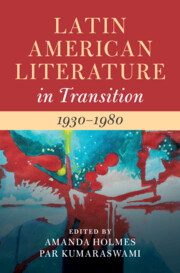Book contents
- Latin American Literature in Transition 1930–1980
- Latin American Literature in Transition
- Latin American Literature in Transition 1930–1980
- Copyright page
- Contents
- Contributors
- Introduction
- Part I War, Revolution, Dictatorship
- Part II Metropolis and Ruins
- Part III Solidarity
- Part IV Aesthetics and Innovation
- Index
- References
Introduction
Transitions in Mid-Century Latin American Literature
Published online by Cambridge University Press: 24 January 2023
- Latin American Literature in Transition 1930–1980
- Latin American Literature in Transition
- Latin American Literature in Transition 1930–1980
- Copyright page
- Contents
- Contributors
- Introduction
- Part I War, Revolution, Dictatorship
- Part II Metropolis and Ruins
- Part III Solidarity
- Part IV Aesthetics and Innovation
- Index
- References
Summary
A series of wars and revolutions provide the fiery, unsettled bedrock for mid-twentieth-century Latin American literature: on a global scale, World War II and the Cold War mar political alliances; the Cuban Revolution, Peronist Argentina, and the 1968 student movements are some of the regional responses that develop from these international conflicts. Latching onto a transforming world, authors in this era appropriate the discomfort of transition to produce literary works of international acclaim. Mid-century Latin American literature has been framed as a market-driven phenomenon that opened the region up through an exoticization that captured international recognition. This volume takes a different approach, one that rests uncomfortably on a deep political instability – worldwide as well as regional – that is engaged aesthetically by literary authors. It argues that the literature of mid-century Latin America locates its strength within global and regional political conflicts, as well as from within the cultural and social tensions spurred on by economic disparities.
- Type
- Chapter
- Information
- Latin American Literature in Transition 1930–1980 , pp. 1 - 14Publisher: Cambridge University PressPrint publication year: 2022

